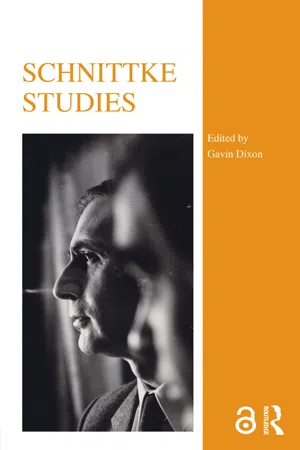
- 274 pages
- English
- ePUB (mobile friendly)
- Available on iOS & Android
Schnittke Studies
About this book
Alfred Schnittke (1934-1998) was arguably the most important Russian composer since Shostakovich, and his music has generated a great deal of academic interest in the years since his death. Schnittke Studies provides a variety of perspectives on the composer and his music. The field is currently diverse and vibrant, and this book demonstrates the range of academic approaches being applied to Schnittke's work and the insights they provide, covering: polystylism, for which Schnittke is best known, the significance of the composer's Christian faith, and detailed formal analyses of key works, with connections drawn between the apparently divergent periods of the composer's career. This book has been prepared as a memorial to Professor Alexander Ivashkin, a leading scholar in the field, who died in 2014, and will be of interest not only to those studying Schnittke's music, but also those with an interest in late Soviet-era music in general.
Chapter 5 of this book is freely available as a downloadable Open Access PDF at http://www.taylorfrancis.com under a Creative Commons Attribution-Non Commercial-No Derivatives (CC-BY-NC-ND) 4.0 license.
Frequently asked questions
- Essential is ideal for learners and professionals who enjoy exploring a wide range of subjects. Access the Essential Library with 800,000+ trusted titles and best-sellers across business, personal growth, and the humanities. Includes unlimited reading time and Standard Read Aloud voice.
- Complete: Perfect for advanced learners and researchers needing full, unrestricted access. Unlock 1.4M+ books across hundreds of subjects, including academic and specialized titles. The Complete Plan also includes advanced features like Premium Read Aloud and Research Assistant.
Please note we cannot support devices running on iOS 13 and Android 7 or earlier. Learn more about using the app.
Information
Part I
Interpretative studies
1 ‘Crucifixus etiam pro nobis’
This symphony is at the same time a mass, but it is less a mass than a symphony, because it refers to the mass only in the beginning of each movement. I begin by quoting Gregorian chorales (either two at once, or one in canon with itself), and then I add orchestral material that is mostly self-sufficient and has nothing to do with the chorale – or it is but a continuation of the chorale.8
We arrived at St Florian at dusk, and the entrance to Bruckner’s tomb was already closed. The cold, dark baroque church was filled with a mystic atmosphere. Behind the wall an invisible choir was singing the evening mass – ‘missa invisibile’ … A year later I received a commission from the BBC Symphony Orchestra to write something for a concert with G. Rozhdestvensky. I thought of a piano concerto. Rozhdestvensky suggested a work dedicated to Bruckner, but I could not think of anything, and then he said ‘Maybe something related to St Florian?’ That was it, and I decided to write an ‘invisible mass’ – a symphony with a choral background. Six movements of the symphony follow the ordinarium of the Mass, and the choir parts quote the liturgical melodies. Can a form which ends with words ‘Give us peace’ ever grow old?13
The entire harmonic content of the symphony, as well as its overall form, were constructed on the principle of the crucifix. How is it possible to build a chord on the basis of a cross? In this case it means that two non-symmetrical chords are interlinked, but their link results in symmetry, and this works in horizontal movement again, so that optically a crucifix is formed. I obeyed this exactly. It was very important for me to discover such a constructive principle, especially for the ‘Credo.’ Everything that happens in the vertical is strictly controlled. Everything must correspond to the principle of the crucifix.21
Table of contents
- Cover
- Half Title
- Title Page
- Copyright Page
- Dedication
- Table of Contents
- List of figures
- List of music examples
- Note on transliteration
- Notes on contributors
- Preface
- Part I Interpretative studies
- Part II Theoretical studies
- Part III Russian perspectives
- Appendix: Revised catalogue of Alfred Schnittke’s Sketches in the Juilliard Manuscript Collection
- Bibliography
- Index